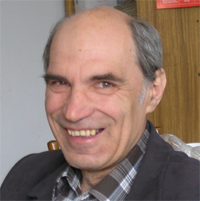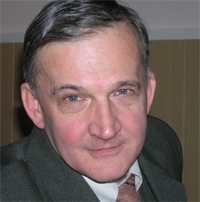|

|
|
Dr.Sci. Leonid Nikiforovich Sinitsa,
Institute of Atmospheric optics of Siberian Branch of Russian Academy of Scienses, Head of Laboratory of Molecular Spectroscopy |
|

|
|
Dr.Sci. Alexandr Dmitrievich Bykov,
Insitute Institute of Atmospheric Optics of Siberian Branch of the Russian Academy of Science, Laboratory of Molecular Spectroscopy |
|

|
|
Dr. Nina Nikolaevna Lavrentieva,
Insitute Institute of Atmospheric Optics of Siberian Branch of the Russian Academy of Science, Laboratory of Molecular Spectroscopy |
 |
|
Dr. Olga Vasilievna Naumenko,
Insitute Institute of Atmospheric Optics of Siberian Branch of the Russian Academy of Science, Laboratory of Molecular Spectroscopy |
Institute of Atmospheric Optics (IAO) group has a big experience in development of high sensitive intracavity laser spectrometers. Since 1972, when this team had began to build up such spectrometers with ruby, Nd-glass, color center lasers with dynamic resonators, they have continuing work in this field, and the team has published first monographs in this subject in Russian and English. These spectrometers allowed to record many weak lines of H2O, CO2, C2H2, CH4, and their isotopomers in the spectral region higher 8000 cm-1. At the present highly sensitive laser spectrometers are widely used in the Laboratory of Molecular Spectroscopy for study of molecules at high excitation (at high emperature, in flame, in discharge).
Laboratory of Molecular Spectroscopy is one of the leading group in the investigation of the absorption spectra of the molecules (H2O, H2S, CO2, etc). The large set of rotational-vibrational energy levels obtained from the high resolution Fourier transform spectra has permitted detailed studies of energy structure in the visible and near infra-red region. It was found that the high-order resonances with large changing of vibrational quantum numbers are typical for the water molecule and they are caused by the strong centrifugal distortion near the linear configuration. These resonances destroy the usual polyad scheme originating from well-known Coriolis, Darling- Dennison and Fermi resonances in H2O molecule.
Theoretical and experimental works for the H2O, H2S, O3 and CO2 line broadening and shifting were fulfilled. Based on exact solutions of classical equations of motion new approach (exact trajectories method) has been developed for the line parameters calculation. It was shown that the compensation of different scattering channel contributions defines the variation of shift coefficients with quantum number increasing. The study of water vapor lines interference as well as connection of intramolecular resonances with non-linear dependence of a line shift on pressure has been performed. The numerous calculations of vibrational-rotational line shifting of H2O, O3, CO2 and CH4 induced by different foreign gases pressure using the Anderson and semiempiric methods have been carried out, error of broadening coefficient calculation is less than 5%.
Special algorithms which use pattern recognition methods were developed for automatic spectra assignment. Data obtained in the group for H2O and H2S species have been included in the spectroscopic databases HITRAN and GEISA.
List of publications
1. A.Bykov, O.Naumenko, L.Sinitsa, B.Voronin, J.-M.Flaud, C.Camy-Peyret, and R.Lanquetin, High-Order resonances in the water molecule, Journal of Molecular Spectroscopy, v.205, 1-8 (2001).
2. A.Bykov, L.Sinitsa. V. Starikov, Experimental and theoretical methods in spectroscopy of the water vapor, Novosibirsk, Publidhing House of SB RAS, 376 pages (In Russian), (1999).
3. L.Sinitsa, Intracavity laser spectroscopy, Proceedings SPIE, Ed: E.Sviridenkov, v.3342, P.268 (1998).
4. A.Valentin, Ch.Claveau, A.Bykov, N.Lavrenyieva, V.Saveliev, L.Sinitsa, The water-vapor nu2 band lineshift coefficients induced by nitrogen pressure, Journal of Molecular Spectroscopy, v.198, 218-229 (1999).
5. Bykov A., Naumenko O.,Smirnov M., Sinitsa L., Linda R.Brown, J.Crisp, D Crisp, The infrared spectrum of H2S from 1 to 5 micron, Canadian Journal of Physics, v.72, 989–1000 (1994). |